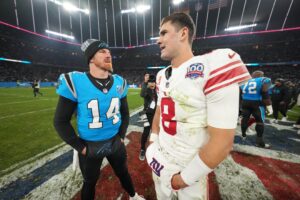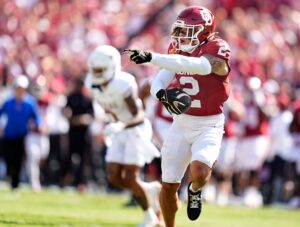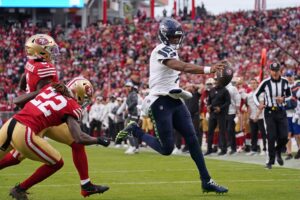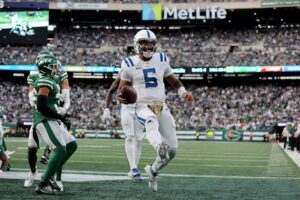The San Francisco 49ers are coming off their bye week and have a 4-6 record. The 49ers defense has been one of the strengths of this team, and have overcome numerous key injuries to still put up productive numbers.
San Francisco 49ers Defense Remains Formidable
Despite the multitude of injuries on the defensive side of the ball, this has still been an above-average unit this season relative to other defenses around the league. What has become clear, however, is that without the services of players like Nick Bosa, Richard Sherman, and Dee Ford, this unit has taken a step back compared to where they were last season.
Pass Rush Not as Potent
One of the biggest revelations this season has been just how crucial Bosa is to the overall welfare and performance of the defense. He is an absolute handful to contain on the pass rush, and his ability to consistently pressure the quarterback creates a chain reaction that benefits all aspects of the defense. He either commands a double team and opens up opportunities for others to get after the quarterback or dominates his opposing blocker and disrupts the rhythm of the quarterback himself. Those quarterbacks get relentlessly harassed, have less time to throw, and often get forced into bad decisions due to that constant bombardment.
The secondary then does not have to cover receivers as long and are not made vulnerable by the quarterbacks getting more time to throw in the pocket and eventually see a receiver create separation. A secondary will always look much stronger throughout a game when a pass rush is consistently getting to the quarterback. Not only do the receivers have less time to gain separation, but quarterbacks will often make errant throws. The secondary can then take advantage of those mistakes and turn them into interceptions.
Going Beyond Bosa
Beyond just the Bosa injury, the 49ers have also lost Solomon Thomas for the rest of the season, and Ford could very well not play again for the rest of the year. A defensive line suffering through that type of talent loss has ramifications that permeate throughout the rest of the defense and changes how they fundamentally play.
The 49ers only blitzed on 20.9% of plays last season because they were confident they would generate enough pass rush just through just their defensive lineman up front. Despite that lack of blitzing, their defense registered a 28.7% pressure rate, which was second in the league. This year, they have had to blitz far more often at 34.1%, and their pressure rate has also fallen to 24.4%. The team averaged three sacks per game last season but is only averaging 1.8 sacks per game this season.
Arik Armstead was a beneficiary of the presence of Bosa last season. Armstead had ten sacks last season but just 1.5 sacks through the first ten games this season. He is also on pace for fewer quarterback hurries and quarterback pressures compared to his previous season, so it is not just a case of him not being able to finish as many sacks. He is not harassing the quarterback nearly as often.
Even with the absence of Bosa, that production drop-off is concerning, given the 49ers essentially chose to reward him with a contract extension over DeForest Buckner, who they traded to the Indianapolis Colts. The good news is that Javon Kinlaw has shown the potential to grow into a force at defensive tackle. However, the limited returns on Armstead in a season without Bosa is troubling, especially considering that he never had more than three sacks in a season before Bosa arrived last year.
Stats That Help Explain Defensive Dropoff
As a whole, this defense is allowing about four more points per game this season compared to last season. Back in 2019, this defense gave up the fewest yards per play in the NFL. This year, they have given up about 0.5 more yards per play and have slipped to 9th in that category. That is not a big yard per play difference, but some numbers explain the points allowed discrepancy.
The 49ers generated a turnover during 14.1% of drives last season, but that rate is down to 10.3% this season. That large turnover rate helped get opposing offenses off the field, and in turn, kept points off the board. The 49ers defense ranked third in the league last season in the fewest percentage of opponent drives resulting in a score at 28.8%. The rate of possessions that have given up a score has soared to 41.1%, which ranks 12th in the league.
Last season, the 49ers’ defense was sixth in turnovers created. This year, their rate of takeaways has fallen. While the yards allowed per play has not been a huge difference, this unit has not forced as many turnovers as last season, and the prolonged possessions result in more points allowed throughout a game.
Getting Off the Field
Beyond those decreased turnovers, there are a few other factors. The defense is 38.8% on third-down conversions this season, which is seventh in the league. However, they were better last season, when their 33.3% was good for third in the NFL. The defense has not been able to get the opposing offseason off the field as frequently after third downs as they were last season, and those lengthened drives will contribute to more points allowed.
The 49ers defense has allowed an average of 29.3 net yards per drive this season, compared to 25.4 net yards per drive last season. The average starting field position for 49ers opponents was between the 28 and 29-yard lines in the previous season. This season, it has been between the 30 and 31-yard lines. The average time the defense was out on the field last season was 2:37, which is nearly the same as the 2:39 average time this season.
No Help From Special Teams, Offense
More yards per drive and better starting field position will contribute to more points allowed, especially when fewer of those drives are ending in turnovers created. These discrepancies take on greater significance when looking at their Red Zone ratings as well. Their defensive Red Zone percentages and the amount of Red Zone trips per game are similar compared to last season, so that aspect isn’t impacting that increase in points allowed.
Better average starting field position, a decrease in third-down stops, and not generating as many turnovers compared to last season are the key factors in the defense giving up more points per game this season. A lot of that goes back to the injuries, though. A more ferocious pass rush not only forces more fumbles but can make the difference on huge third down plays that can ultimately end drives. Also, if there are holes in the secondary that result from injuries, a quarterback knows which inexperienced players in that secondary he can exploit on those big third down plays.
There are still a lot of things to admire about this 49ers’ defense, though. Only the Colts have missed fewer tackles than the 49ers, and they rank sixth in fewest rushing yards allowed per attempt at 3.9 and have also given up the sixth-fewest rushing touchdowns. During such a tumultuous season, one of the highlights of this defense has been the continued progression of Fred Warner as arguably the best middle linebacker in football. He’s excellent in coverage against opposing tight ends and has such a nose for sniffing out developing holes in the run defense.
Secondary Especially Decimated by Injuries
The secondary has been hit really hard by injuries this season, and there have been times that practice squad guys have had to play significant roles in the pass defense. There have been numerous times where they desperately needed Sherman’s talent and leadership presence out on the field. Nearly every key player in the secondary has missed time this season, and combined with the pass rush not getting to the quarterback with the same frequency it did last year, there have been some quarterbacks who were able to exploit those vulnerabilities.
Some good news is that Jason Verrett has been able to re-establish himself in this league after struggling through so many injuries these last few years. The secondary allowed an opposing QB rating of just 83.0 last season, which was the seventh-lowest in the league. This year, that rating has gone up to 92.8, which is the 13th lowest. Given the injuries suffered by guys like Sherman, K’Waun Williams, Jaquiski Tartt, and Ahkello Witherspoon, it’s noteworthy that this unit’s numbers are as good as they are. They’ve given up the third-fewest air yards on completions and the fourth-fewest yards after the catch.
There’s no reason to believe that this defense won’t return to being elite instead of just good once more pieces return. Unfortunately, many of those key pieces probably aren’t going to return until next season, and the free agency period also brings with it the typical unknown variables of an NFL offseason. The 2019 defense was dominant, and it’s a testament to the depth of this squad that so many injuries have befallen this team and yet they remain one of the above-average groups relative to the rest of the league.
Main photo:
Embed from Getty Images






